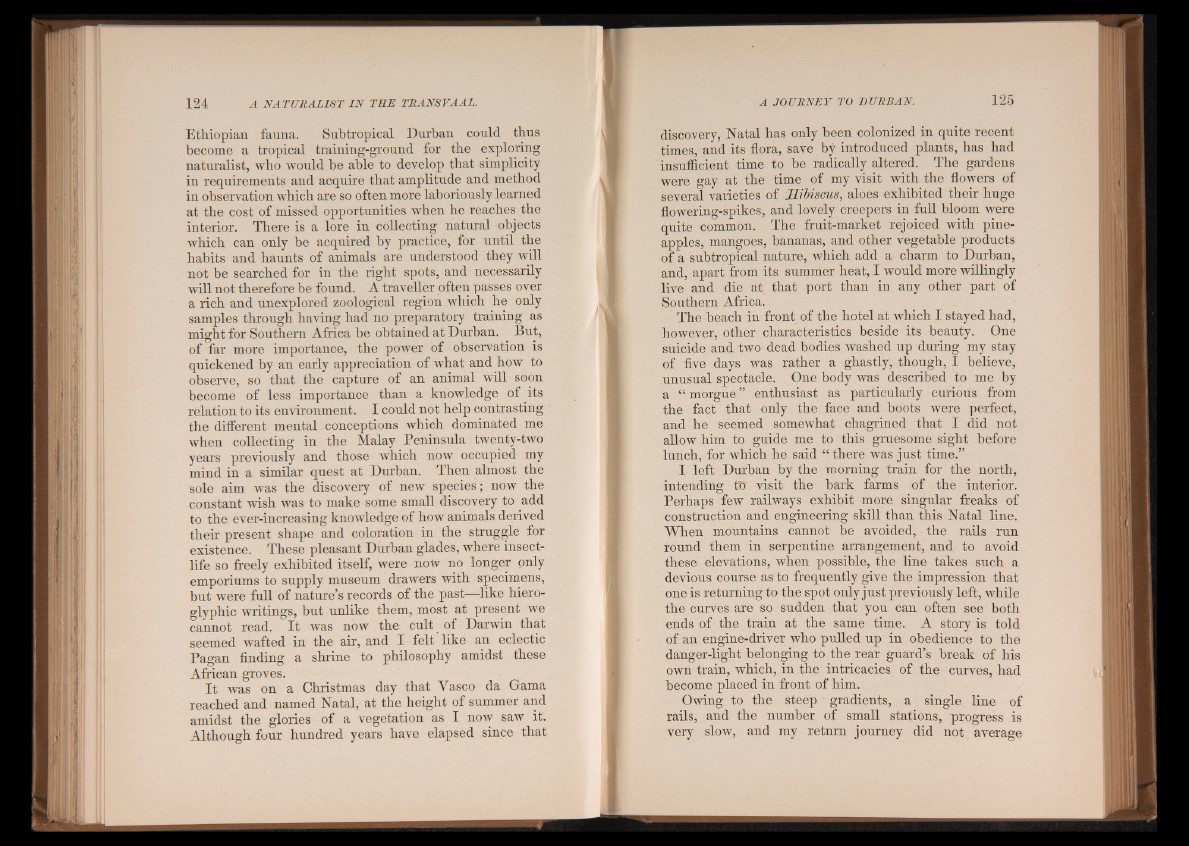
Ethiopian fauna. Subtropical Durban could thus
become a tropical training-ground for the exploring
naturalist, who would he able to develop that simplicity
in requirements and acquire that amplitude and method
in observation which are so often more laboriously learned
at the cost of missed opportunities when he reaches the
interior. There is a lore in collecting natural objects
which can only be acquired by practice, for until the
habits and haunts of animals are understood they will
not be searched for in the right spots, and necessarily
will not therefore be found. A traveller often passes over
a rich and unexplored zoological region which he only
samples through having had no preparatory training as
might for Southern Africa be obtained at Durban. But,
of far more importance, the power of observation is
quickened by an early appreciation of what and how to
observe, so that the capture of an animal will soon
become of less importance than a knowledge of its
relation to its environment. I could not help contrasting
the different mental -conceptions which dominated me
when collecting in the Malay Peninsula twenty-two
years previously and those which now occupied my
mind in a similar quest at Durban. Then almost the
sole aim was the discovery of new species; now the
constant wish was to make some small discovery to add
to the ever-increasing knowledge of how animals derived
their present shape and coloration in the struggle for
existence. These pleasant Durban glades, where insect-
life so freely exhibited itself, were now no longer only
emporiums to supply museum drawers with specimens,
but were full of nature’s records of the past—like hieroglyphic
writings, but unlike them, most at present we
cannot read. It was now the cult of Darwin that
seemed wafted in the air, and I felt like an eclectic
Pagan finding a shrine to philosophy amidst these
African groves.
I t was on a Christmas day that Vasco da Gama
reached and named Natal, at the height of summer and
amidst the glories of a vegetation as I now saw it.
Although four hundred years have elapsed since that
discovery, Natal has only been colonized in quite recent
times, and its flora, save by introduced plants, has had
insufficient time to be radically altered. The gardens
were gay at the time of my visit with the flowers of
several varieties of Hibiscus, aloes exhibited their huge
flowering-spikes, and lovely creepers in full bloom were
quite common. The fruit-market rejoiced with pineapples,
mangoes, bananas, and other vegetable products
of a subtropical nature, which add a charm to Durban,
and, apart from its summer heat, I would more willingly
live and die at, that port than in any other part of
Southern Africa.
The beach in front of the hotel at which I stayed had,
however, other characteristics beside its beauty. One
suicide and two dead bodies washed up during my stay
of five days was rather a ghastly, though, I believe,
unusual spectacle. One body was described to me by
a “ morgue ” enthusiast as particularly curious from
the fact that only the face and boots were perfect,
and he seemed somewhat chagrined that I did not
allow him to guide me to this gruesome sight before
lunch, for which he said “ there was just time.”
I left Durban by the morning train for the north,
intending to visit the bark farms of the interior.
Perhaps few railways exhibit more singular freaks of
construction and engineering skill than this Natal line.
When mountains cannot be avoided, the rails run
round them in serpentine arrangement, and to avoid
these elevations, when possible, the line takes such a
devious course as to frequently give the impression that
one is returning to the spot only just previously left, while
the curves are so sudden that you can often see both
ends of the train at the same time. A story is told
of an engine-driver who pulled up in obedience to the
danger-light belonging to the rear guard’s break of his
own train, which, in the intricacies of the curves, had
become placed in front of him.
Owing to the steep gradients, a single line of
rails, and the number of small stations, progress is
very slow, and my retnrn journey did not average